2021 Polestar 1 Pilot Assist
Adjusting set speed for driver support

| Set speed |
-
Change a set speed by pressing the
 (1) or
(1) or  (2) buttons briefly or by pressing and holding them:
(2) buttons briefly or by pressing and holding them:- Brief press: Each press changes the speed in +/- 5 km/h (+/- 5 mph) increments.
- Press and hold: Release the button when the set speed indicator (3) has moved to the desired speed.
> The most recently set speed will be stored.
For vehicles without Adaptive Cruise Control*, speed instead increases by +/- 1km/h (+/- 1 mph) each time the button is pressed.
Using the accelerator pedal
If speed is increased by depressing the accelerator pedal while pressing the ![]() (1) button on the steering wheel, the vehicle’s speed when the button is pressed will be stored as the set speed.
(1) button on the steering wheel, the vehicle’s speed when the button is pressed will be stored as the set speed.
Temporarily increasing speed using the accelerator pedal, e.g. when passing another vehicle, will not affect the setting. The vehicle will return to the set speed when the accelerator pedal is released.
Possible speed
The lowest speed that can be set is 30 km/h (20 mph). When following another vehicle, ACC can monitor that vehicle’s speed and slow your own vehicle down to a standstill, but it is not possible to set speeds lower than 30 km/h (20 mph).
The driver support functions can follow another vehicle at speeds from a standstill up to 200 km/h (125 mph).
Pilot Assist can provide steering assistance from near-stationary speeds up to 140 km/h (87 mph).
Auto-hold braking with driver support
Braking function in slow traffic and at a standstill
In slow-moving, stop-and-go traffic or when stopped at a traffic light, driving will resume automatically if the vehicle is stopped for less than approx. 3 seconds. If it takes more than 3 seconds for the vehicle ahead to begin moving again, the driver support function will go into standby mode and the auto-hold brake function will activate.
-
The function can be reactivated by:
- Pressing the
 button on the steering wheel keypad.
button on the steering wheel keypad. - Pressing the accelerator pedal.
- Pressing the
> The function will resume following the vehicle ahead if it begins to move within approx. 6 seconds.
A noticeable increase in speed may follow when the speed is resumed with the ![]() steering wheel button.
steering wheel button.
The driver support system only issues a warning for obstacles detected by its camera and radar units, which means that warnings may come after a delay or not at all.
- Never wait for a warning or assistance. Apply the brakes when necessary.
NOTE
Driver support can keep the vehicle stationary for no more than 5 minutes – after that time the parking brake is applied and the function is deactivated.
The parking brake must be released before driver support can be reactivated.
Deactivation of the Auto-hold brake function
In certain situations, auto-hold will be deactivated when the vehicle is at a standstill and the function will go into standby mode. This means that the brakes will be released and the vehicle could begin to roll. The driver must actively apply the brakes to keep the vehicle stationary.
This can occur if:
- The driver depresses the brake pedal.
- The parking brake is applied.
- The gear selector is moved to the P, N or R positions.
- The driver puts Adaptive Cruise Control or Pilot Assist in standby mode.
Auto Activate Parking Brake
The parking brake is applied if the function is keeping the vehicle stationary using the brakes and:
- The driver opens the door or unbuckles his/her seat belt.
- The function has kept the vehicle at a standstill for more than approx. 5 minutes.
- The brakes overheat.
- The driver switches off the engine.
Collision risk warning from driver support
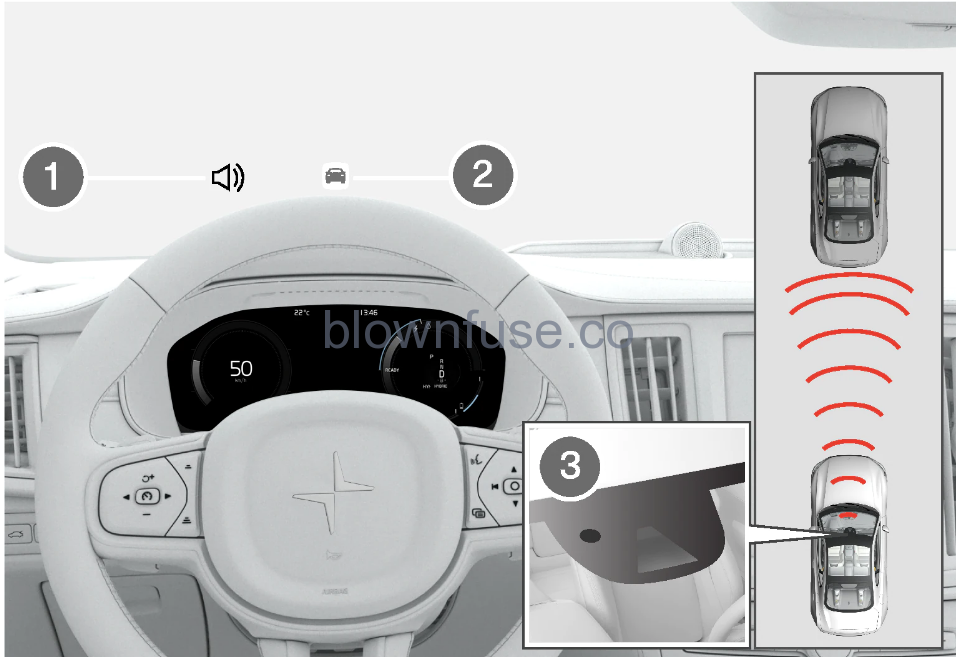
- Collision warning audible signal and symbol
- Collision warning audible signal
- Collision warning symbol
Adaptive Cruise Control and Pilot Assist use approx. 40% of the braking capacity. If a situation requires more braking force than driver support can provide, and if the driver does not apply the brakes, a warning light and audible warning signal will be activated to alert the driver that immediate action is required.
The driver support system only issues a warning for vehicles detected by its radar unit – thus, a warning may come after a delay or not at all. Never wait for a warning. Apply the brakes when necessary.
Visual warnings on the windshield may be difficult to notice in cases of strong sunlight, reflections, extreme light contrasts, or if the driver is wearing sunglasses or is not looking straight ahead.
Deactivating Pilot Assist
(Depending on market, this function can be either standard or optional.)
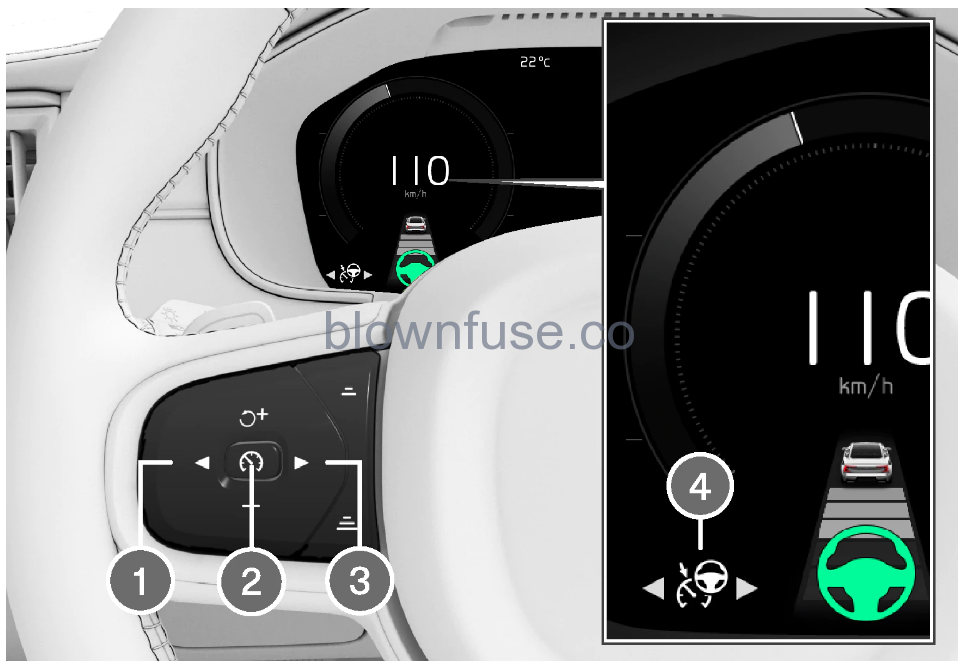
A green steering wheel indicates that Pilot Assist is providing steering assistance.
- Press the
 button on the steering wheel (2).
button on the steering wheel (2).
> The symbol and markings turn gray – Pilot Assist goes into standby mode. The time interval indicator light and any symbols for the target vehicle will go out.
-
Press the
 (1) or
(1) or  (3) buttons on the steering wheel to select another function.
(3) buttons on the steering wheel to select another function.
> The Pilot Assist symbol and marking (4) in the instrument panel will go out and the set/stored maximum speed will be erased.
- With Pilot Assist in standby mode, the driver must intervene and steer and regulate both speed and distance to the vehicle ahead.
- If the vehicle comes too close to a vehicle ahead when Pilot Assist is in standby mode, the driver is instead warned of the short distance by the Distance Alert* function.
Differences between Pilot Assist and Lane Keeping Aid
- Can help to keep the vehicle within its lane by assisting with steering in some cases.
- Can help to maintain a preset speed or the distance to the vehicle ahead by means of acceleration and braking operations.
When the steering wheel in the middle is extinguished, Pilot Assist is running but steering assistance is not active.
When the steering wheel is illuminated, Pilot Assist is running and steering assistance is active.
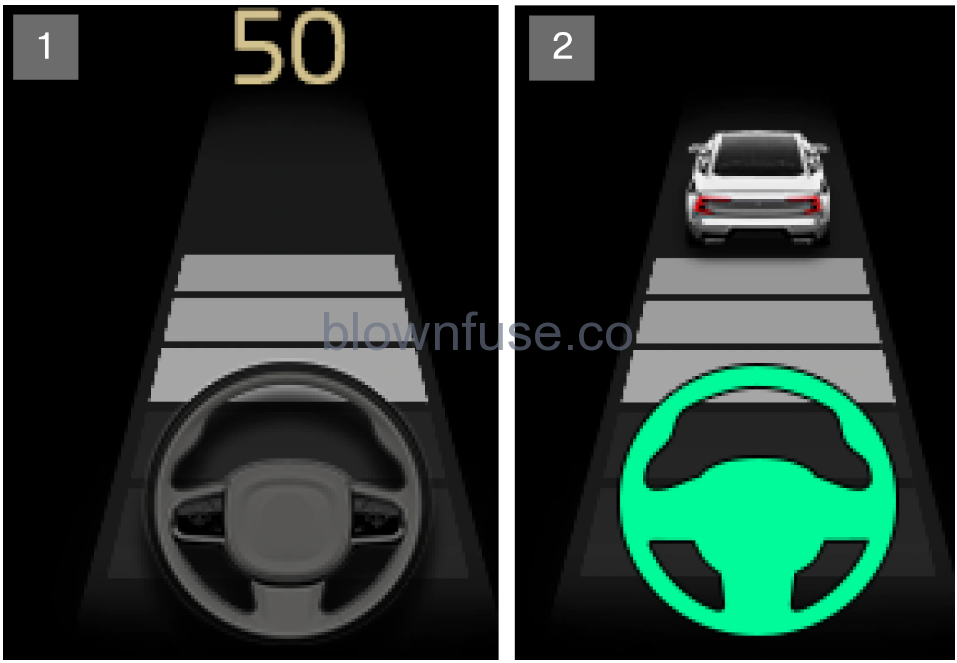
2 When the steering wheel symbol in the instrument panel is illuminated, Pilot Assist is helping you to steer.
Lane Keeping Aid can provide steering assistance and/or a warning to the driver when the vehicle is about to leave its lane unintentionally. The function is active between 65-200 km/h (40-125 mph) on roads with clearly visible side markings.
- Lane Keeping Aid can provide the driver with steering assistance, steering the vehicle back into its lane and/or providing warnings using acoustic signals or steering wheel vibration.
 The Gray symbol in the instrument panel means that the function is on but that the conditions for LKA have not been met.
The Gray symbol in the instrument panel means that the function is on but that the conditions for LKA have not been met. The white symbol in the instrument panel means that the conditions for LKA have been met and that the function is available.
The white symbol in the instrument panel means that the conditions for LKA have been met and that the function is available. The orange symbol in the instrument panel means that LKA provides steering assistance back into the lane and/or gives a warning with sound or vibration in the steering wheel.
The orange symbol in the instrument panel means that LKA provides steering assistance back into the lane and/or gives a warning with sound or vibration in the steering wheel.- The function is supplementary driver support intended to facilitate driving and help make it safer – it cannot handle all situations in all traffic, weather and road conditions.
- The driver is advised to read all sections in the Manual about this function to learn of its limitations, which the driver must be aware of before using the function.
- Driver support functions are not a substitute for the driver’s attention and judgment. The driver is always responsible for ensuring the vehicle is driven in a safe manner, at the appropriate speed, with an appropriate distance to other vehicles, and in accordance with current traffic rules and regulations.
Pilot Assist
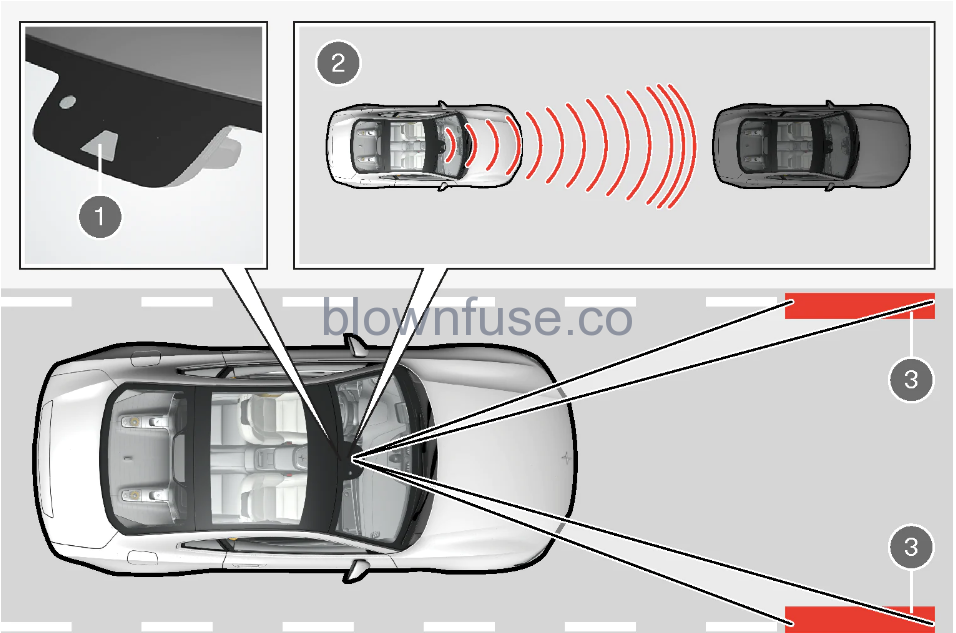
The camera/radar sensor monitors the distance to the vehicle ahead and detects lane markings.
- Camera and radar sensor
- Distance detection
- Lane marking detection
The Pilot Assist function is primarily intended for use on highways and other major roads where it can help provide a more comfortable and relaxing driving experience.
The driver sets the desired speed and distance to the vehicle ahead. Pilot Assist monitors the distance to the vehicle ahead and the traffic lane’s side markers using the camera and radar sensor. The system maintains the set time interval to the vehicle ahead by automatically adjusting your vehicle’s speed and keeps your vehicle in its lane by providing steering assistance.
Pilot Assist regulates speed by accelerating and braking. It is normal for the brakes to emit a slight sound when they are being used to adjust speed.
Pilot Assist attempts to:
- smoothly regulate speed. The driver must apply the brakes in situations requiring immediate braking. For example, when there are great differences in speed between vehicles or if the vehicle ahead brakes suddenly. Due to limitations in the camera and radar sensor, braking may occur unexpectedly or not at all.
- follow a vehicle ahead in the same lane and maintain a time interval to that vehicle set by the driver. If the radar sensor does not detect a vehicle ahead, it will instead maintain the speed set by the driver. This will also happen if the speed of the vehicle ahead exceeds the set speed for your vehicle.
If Pilot Assist does not position the vehicle appropriately in the lane, the driver should turn off Pilot Assist or switch to Adaptive Cruise Control*.

The current status of steering assistance is indicated by the steering wheel symbol:
• Illuminated indicates that steering assistance is active.
• Extinguished (as shown in illustration) indicates that steering assistance is deactivated.
Pilot Assist‘s steering assistance is based on monitoring the direction of the vehicle ahead and the traffic lane’s side marker lines. The driver can override Pilot Assist‘s steering recommendations at any time and steer in another direction, e.g. to change lanes or avoid obstacles on the road. Resistance will be felt in the steering wheel as long as steering assistance is active.
If Pilot Assist cannot clearly interpret the lane’s side marker lines and if the camera/radar sensor is unable for some other reason to clearly interpret the lane, Pilot Assist will temporarily deactivate steering assistance. However, the speed and distance warnings will remain active. Steering assistance will resume when the side marker lines can once again be interpreted. The driver will be alerted by slight vibrations in the steering wheel that the function has been temporarily deactivated.
Pilot Assist is deactivated automatically and resumes working without prior notice.
When the vehicle is approaching an off-ramp or a fork in the road, the driver should steer toward the desired lane so that Pilot Assist can detect the desired direction of travel.

If Pilot Assist detects that the driver does not have their hands on the steering wheel, the system will remind the driver to actively steer the vehicle with a symbol and text message in the instrument panel.
If the driver’s hands are still not detected on the steering wheel after a few seconds have passed, the instructions to actively steer the vehicle will be repeated, accompanied by an audible signal.
If Pilot Assist still does not detect the driver’s hands on the steering wheel after a few more seconds have passed, the audible signal will become intense and the steering function will switch off. Pilot Assist must then be reactivated by pressing the ![]() button on the steering wheel.
button on the steering wheel.
- The function is supplementary driver support intended to facilitate driving and help make it safer – it cannot handle all situations in all traffic, weather and road conditions.
- The driver is advised to read all sections in the Manual about this function to learn of its limitations, which the driver must be aware of before using the function.
- Driver support functions are not a substitute for the driver’s attention and judgment. The driver is always responsible for ensuring the vehicle is driven in a safe manner, at the appropriate speed, with an appropriate distance to other vehicles, and in accordance with current traffic rules and regulations.
Only a workshop may perform maintenance on driver support components – contact Polestar Customer Support.
Pilot Assist* controls
 Function buttons and symbols.
Function buttons and symbols.
| ▶: Switches from Adaptive Cruise Control to Pilot Assist | |
| Increases the time interval to the vehicle ahead | |
| Reduces the time interval to the vehicle ahead | |
| ◀: Switches from Pilot Assist to Adaptive Cruise Control | |
| Function symbol | |
| Symbols for target vehicle | |
| Symbol for time interval to the vehicle ahead | |
| Symbol for activated/deactivated steering assistance |
Pilot Assist displays
(Depending on market, this function can be either standard or optional)
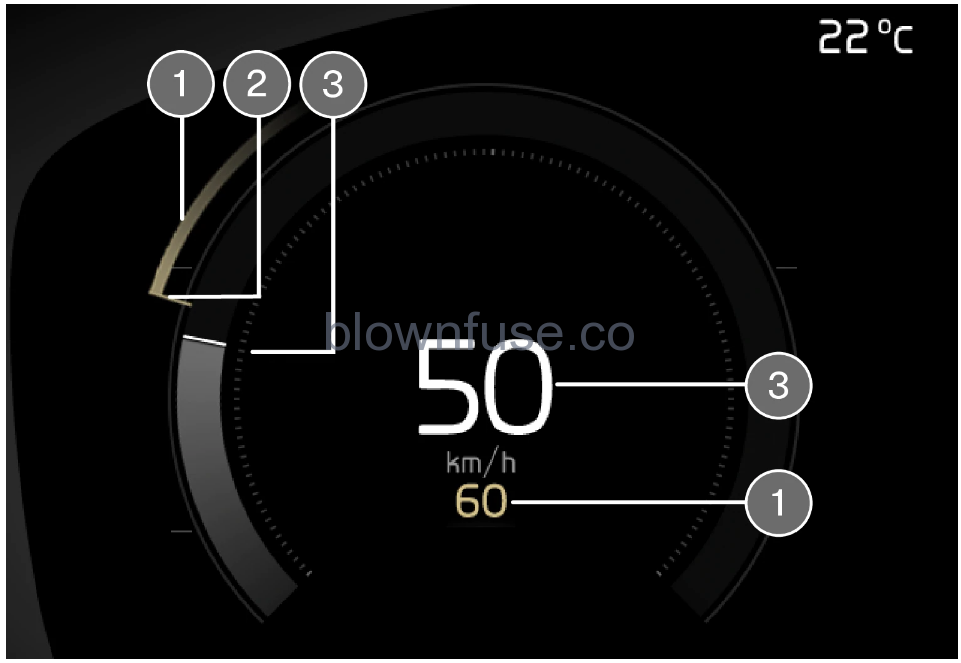
- Speed indicators.
- Set speed
- Speed of the vehicle ahead
Time interval
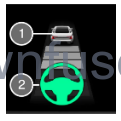
Pilot Assist will only regulate the time interval to the vehicle ahead when the distance symbol shows a vehicle (1) over the steering wheel symbol. Pilot Assist‘s steering assistance is only active when the steering wheel symbol (2) changes from GRAY to GREEN.
When driving
In the following illustration, Road Sign Information (RSI)(Road Sign Information) indicates that the maximum permitted speed is 130 km/h (80 mph).

The previous illustration shows that Pilot Assist is set to maintain a speed of 110 km/h (68 mph) and that there is no target vehicle ahead to follow.
Pilot Assist will not provide any steering assistance because it cannot detect the lane’s side marking lines.
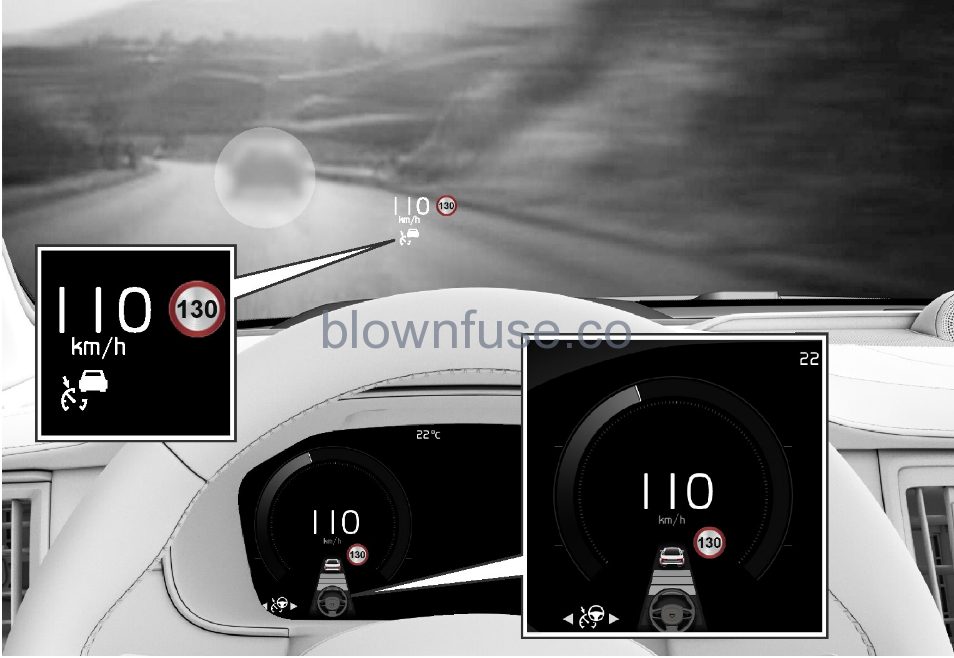
The previous illustration shows that Pilot Assist is set to maintain a speed of 110 km/h (68 mph) and is following a target vehicle ahead that is traveling at the same speed.
Pilot Assist will not provide any steering assistance because it cannot detect the lane’s side marking lines.
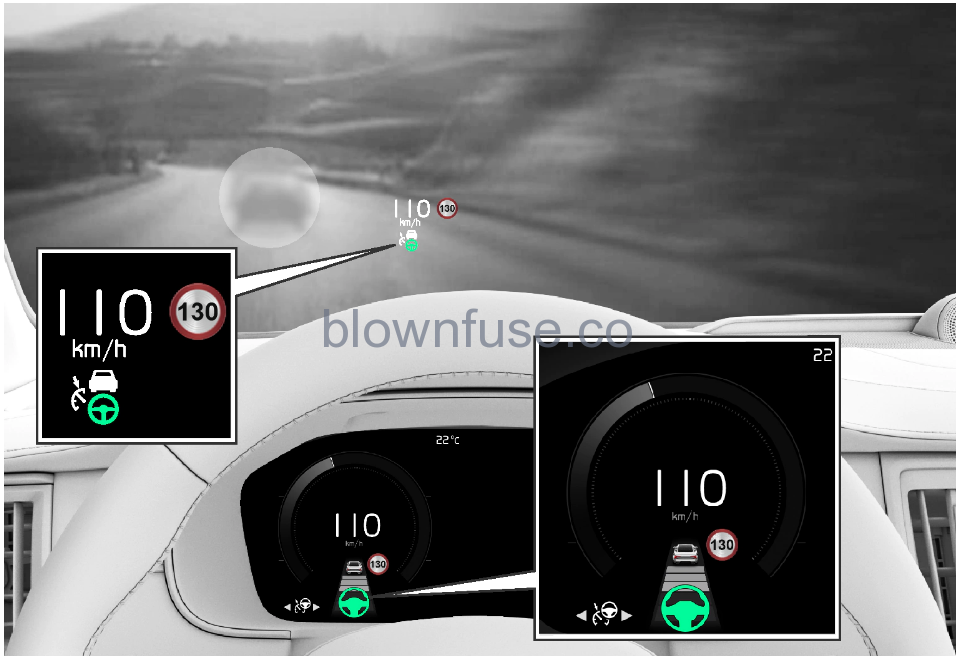
The previous illustration shows that Pilot Assist is set to maintain a speed of 110 km/h (68 mph) and is following a target vehicle ahead that is traveling at the same speed.
In this example, Pilot Assist will also provide steering assistance because it can detect the lane’s side marking lines.

The previous illustration shows that Pilot Assist is set to maintain a speed of 110 km/h (68 mph) and that there is no target vehicle ahead to follow.
Pilot Assist will provide steering assistance because it can detect the lane’s side marking lines.
Pilot Assist limitations
(Depending on market, this function can be either standard or optional)
In some situations, Pilot Assist may have trouble helping the driver properly or may be deactivated automatically – we advise against using Pilot Assist in such cases. Examples of such situations include:
- unclear, worn, or missing lane markings; lane markings that cross over each other; and multiple sets of road markings.
- when the lane divisions change; for example, when lanes divide or merge on highway exits or entrances.
- when there is road construction or there are sudden roadway changes; for example, when lines no longer mark the correct route.
- edges or other lines than lane markings are present on or near the road, e.g. curbs, joints or repairs to the road surface, edges of barriers, roadside edges or strong shadows.
- the lane is narrow or winding.
- the lane contains ridges or holes.
- weather conditions are poor, e.g. rain, snow or fog or slush or reduced visibility with poor light conditions, backlighting, wet road surface, etc.
The driver should also note that Pilot Assist has the following limitations:
- High curbs, roadside barriers, temporary obstacles (traffic cones, safety barriers, etc.) are not detected. Alternatively, they may be detected incorrectly as lane markings, with a subsequent risk of contact between the vehicle and such obstacles. The driver is responsible for ensuring that the vehicle maintains a suitable distance from such obstacles.
- The camera and radar sensors do not have the capacity to detect all oncoming objects and obstacles in traffic environments, e.g. potholes, stationary obstacles or objects that completely or partially block the route.
- Pilot Assist does not “see” pedestrians, animals, etc.
- The recommended steering input is limited in force, which means that it cannot always help the driver to steer and keep the vehicle within the lane.
- In vehicles equipped with Sensus Navigation, the function is able to use information from map data, which could cause variations in performance.
- Pilot Assist will be switched off if the speed-dependent power steering wheel resistance is working at reduced power, e.g. during cooling due to overheating.
Pilot Assist should only be used if there are clear lane lines painted on each side of the lane. All other use will increase the risk of contact with nearby obstacles that cannot be detected by the functions.
The driver can always correct or adjust steering assistance provided by Pilot Assist by turning the steering wheel to the desired position.
Steep roads and/or heavy loads
Pilot Assist is primarily intended to be driven on flat roads. The function may not be able to maintain the correct time interval to the vehicle ahead when driving down steep hills. The driver should be extra attentive and prepared to apply the brakes.
Do not use Pilot Assist if the vehicle is carrying a heavy load.
- This is not a collision-avoidance system. The driver is always responsible and must intervene if the system fails to detect a vehicle ahead.
- The function does not brake for people or animals and does not brake for small vehicles, such as bikes and motorcycles. Similarly, it does not brake for low trailers, oncoming, slow-moving or stationary vehicles and objects.
- Do not use the function in demanding situations, such as in city traffic, at intersections, on slippery surfaces, with a lot of water or slush on the road, in heavy rain/snow, in poor visibility, on winding roads, or on on/off ramps.
The function uses the vehicle’s camera and/or radar units, which have certain general limitations.
Pilot Assist standby mode
(Depending on market, this function can be either standard or optional)
Standby mode means that the function is selected in the instrument panel but not activated. In standby mode, Pilot Assist will not regulate the speed or distance to the vehicle ahead or provide steering assistance.
Standby mode due to action by the driver
Pilot Assist will be deactivated in put in standby mode if any of the following occurs:
- The brakes are applied.
- The gear selector is moved to N.
- A turn signal is used for more than 1 minute.
- The vehicle is driven faster than the set speed for more than 1 minute.
Automatic standby mode
With automatic standby mode, the driver is warned by an acoustic signal and a message on the instrument panel.
- The driver must then regulate vehicle speed, apply the brakes if necessary, and maintain a safe distance to other vehicles.
Adaptive Cruise Control may go into standby mode if:
- Any of the systems that Pilot Assist is dependent on stops working, e.g. stability control/anti-skid (ESC).(Electronic Stability Control)
- Hands are not on the steering wheel.
- The driver opens the door.
- The driver unbuckles the seat belt.
- The engine speed (rpm) is too low/high.
- One or more of the wheels lose traction.
- The brake temperature is high.
- The parking brake is applied.
- The camera/radar sensor is covered by snow or heavy rain (the camera lens/radar waves are blocked).
- Your vehicle’s speed goes under 5 km/h (3 mph) and Pilot Assist cannot determine if the object ahead is a stationary vehicle or if it is another object, e.g. a speed bump.
- Your vehicle’s speed goes under 5 km/h (3 mph) and the vehicle ahead turns so that Pilot Assist no longer has a vehicle to follow.
Pilot Assist* symbols and messages
| Symbol | Message | Meaning |
|---|---|---|
 |
Gray steering wheel symbol | Indicates disabled steering assistance. The steering wheel is illuminated when Pilot Assist is providing steering assistance. |
 |
Symbol for hands on the wheel | The system cannot detect the driver’s hands on the steering wheel. Put your hands on the steering wheel and actively steer the vehicle. |
 |
Windscreen sensor
Sensor blocked, see Manual |
Clean the windshield in front of the camera and radar sensors. |
A text message can be erased by briefly pressing the  button in the center of the right-side steering wheel keypad. If a message cannot be erased, contact Polestar Customer Support.
button in the center of the right-side steering wheel keypad. If a message cannot be erased, contact Polestar Customer Support.
Selecting and activating Pilot Assist*
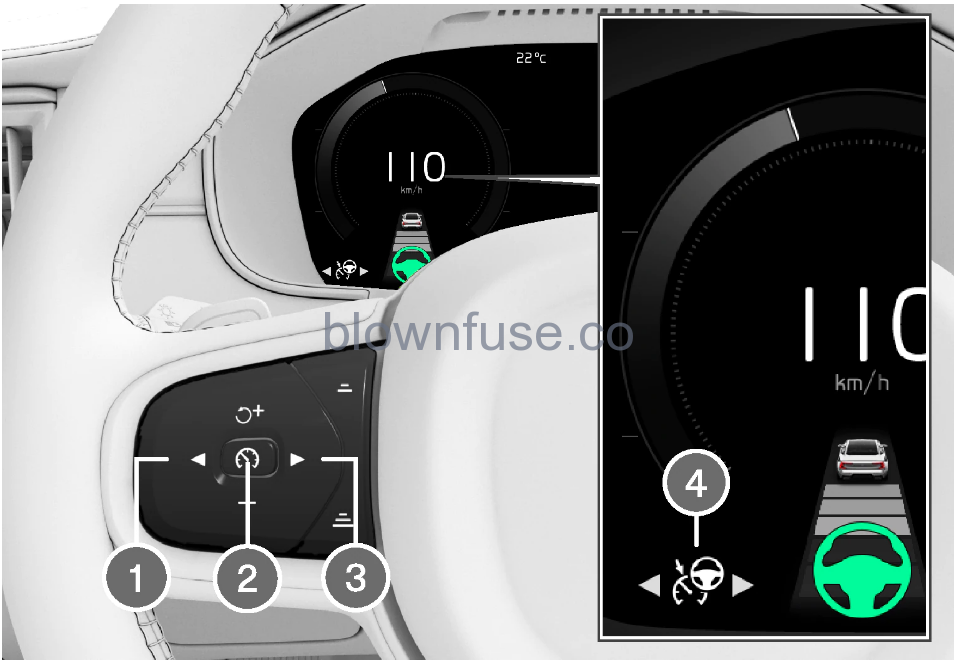
A green steering wheel indicates that Pilot Assist is providing steering assistance.
To start Pilot Assist.
- The driver’s seat belt must be buckled and the driver’s door must be closed.
- The side markings of the lane must be clearly visible and detected by the vehicle.
- There must be a vehicle ahead (target vehicle) within a reasonable distance or your vehicle’s current speed must be at least 15 km/h (9 mph).
- The speed must not exceed 140 km/h (87 mph).
- The driver must keep their hands on the steering wheel.
-
Press the
 (1) or
(1) or  (3) button on the steering wheel keypad and scroll to the Pilot Assist symbol
(3) button on the steering wheel keypad and scroll to the Pilot Assist symbol  (4).
(4).
> Gray symbol – Pilot Assist is in standby mode.
- When Pilot Assist is selected, press
 (2) on the steering wheel keypad to activate.
(2) on the steering wheel keypad to activate.
> White symbol – Pilot Assist starts and the current speed is stored as the maximum speed.
Reactivating Pilot Assist to the last stored speed
- When Pilot Assist is selected, press
 on the steering wheel keypad to activate.
on the steering wheel keypad to activate.
> The Cruise Control marking in the instrument panel will change from GRAY to WHITE and the vehicle will then return to the most recently set speed.
A noticeable increase in speed may follow when the speed is resumed with the ![]() steering wheel button.
steering wheel button.
Setting time intervals to the vehicle ahead
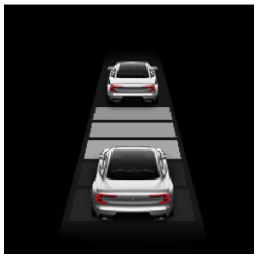
Different time intervals to the vehicle ahead can be selected and are shown in the instrument panel as 1–5 horizontal bars. The more bars, the longer the time interval. One bar represents an interval of approx. 1 second to the vehicle ahead. 5 bars represents approx. 3 seconds.
When the symbol in the instrument panel shows a vehicle and a steering wheel, Pilot Assist is following a vehicle ahead at a preset time interval.
When only a steering wheel is shown, there is no vehicle ahead within a reasonable distance.
When the symbol in the instrument panel shows two vehicles, the Adaptive Cruise Control is following the vehicle ahead at a preset time interval.
When only one vehicle is shown, there is no vehicle ahead within a reasonable distance.

- Controls for setting a time interval.
- Reduce the time interval
- Increase the time interval
- Press the (1) or (2) button to decrease or increase the time interval.
> The distance indicator (3) shows the current time interval.
In order to help your vehicle follow the vehicle ahead as smoothly and comfortably as possible, Adaptive Cruise Control allows the time interval to vary noticeably in certain situations. At low speeds, when the distance to the vehicle ahead is short, Adaptive Cruise Control increases the time interval slightly.
- The greater the vehicles’ speed, the greater the distance between them for a set time interval.
- Only use the time intervals permitted by local traffic regulations.
- If driver support does not seem to respond with a speed increase when activated, it may be because the time interval to the vehicle ahead is shorter than the set time interval.
- Only use a time interval suitable for the current traffic conditions.
- The driver should be aware that short time intervals give them limited time to react and act to any unforeseen traffic situation.
Switching target vehicles with driver support
Switching target vehicles
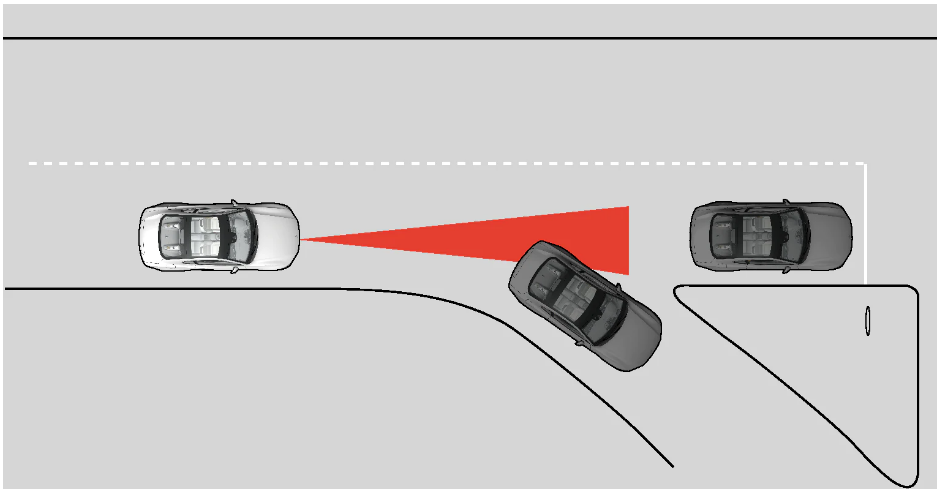
If the target vehicle ahead turns suddenly, there may be stationary traffic ahead.
When driver support is actively following another vehicle at speeds under 30 km/h (20 mph) and switches targets from a moving vehicle to a stationary vehicle, driver support will brake for the stationary vehicle.
When driver support follows another vehicle at speeds over approx. 30 km/h (20 mph) and changes the target vehicle – from a moving vehicle to a stationary one – driver support will ignore the stationary vehicle and instead accelerate to the stored speed.
- The driver must then intervene and apply the brakes.
Driver support disengages and goes into standby mode if:
- your vehicle’s speed goes under 5 km/h (3 mph) and driver support cannot determine if the target is a stationary vehicle or if it is another object, e.g. a speed bump.
- your vehicle’s speed goes under 5 km/h (3 mph) and the vehicle ahead turns so that driver support no longer has a vehicle to follow.
Temporarily deactivating steering assistance with Pilot Assist
(Depending on the market, this function can be either standard or optional)
When the turn signals are used, Pilot Assist‘s steering assistance will be temporarily deactivated. When the direction indicator is switched off, the steering assistance is automatically disengaged if the side lane markings can still be detected.
If Pilot Assist cannot clearly interpret the lane’s side marker lines or if the camera/radar sensor is unable for some other reason to clearly interpret the lane, Pilot Assist will temporarily deactivate steering assistance. However, the speed and distance warnings will remain active. Steering assistance will resume when the side marker lines can once again be interpreted. In these situations, the driver may be alerted through slight vibrations in the steering wheel that steering assistance is temporarily deactivated.

